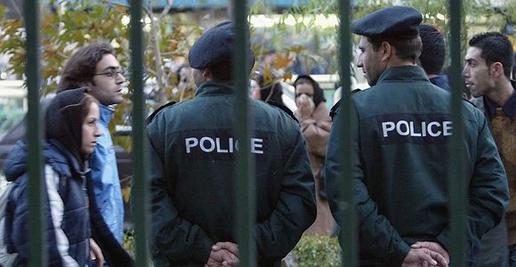Wherever power or wealth accumulates without adequate checks or accountability, corruption becomes a near-inevitable outcome. In Iran almost every official institution, from municipalities to courts to the police, are affected by this destructive tendency. The most common face of corruption in Iran is bribery: so much so that between six and 13 percent of all respondents in a survey by Iran Open Data this year said they had resorted to bribery in their last contact with officials.
Several academic papers recently published in Iran have also examined the factors behind this phenomenon – and most especially, what compels police and law enforcement officers to take bribes. The below is a summary of what they found.
***
Little is known about the depth and extent of corruption in the judiciary, police, and armed forces due to sensitivity of these institutions in the Islamic Republic. Cases of bribery, nepotism, conflicts of interest and the bypassing of official mechanisms for personal gain rarely find their way into state-controlled Iranian media, unless one party or another ends up in a courtroom. But even then, the corruption trials of senior figures such as judges and politicians are often held behind closed doors. The public is deprived of a proper understanding of the extent and nature of corruption in Iran: they know only that it is there.
The Islamic Republic has failed to address corruption – and indeed, made sustained efforts to whitewash it – for more than 40 years now. The official justification for keeping press and public away from important court cases is security: were a military officer tried in public, for example, the argument goes it could weaken the armed forces’ reputation and its ability to protect and serve. This policy and the absence of appropriate punishments for financial crimes have effectively given corrupt approaches the green light. Bribery involving military men, police officers and other law enforcement agencies in Iran has been described as “systemic”.
The ‘Three Levels’ of Iranian Police Corruption
The police force is entrusted with fighting corruption by law. But there are signs Iranian police are aware of quite how hopelessly compromised they are on this particular mission. Last year the quarterly journal Security and Law Enforcement Studies, an official police publication, shared a study Explaining the Factors Affecting the Tendency in Police Officers to Accept Bribes.
The report divided up the contributing factors into individual circumstances, issues related to management, and structural problems. In the first case, it found, officers were more likely to take bribes if they were experiencing financial or family problems. The “normalization” of crime in some areas was also a factor, as was the ability to “adapt” people in a given area to accept the concealing or non-investigation of a crime.
Factors listed under “management” included the enlisting of people with criminal records to serve as police officers. Disparities and discrimination in wages also played a role, as did the simple “lack of adequate oversight” by responsible officers. Structurally, the report found, the police suffered from “inefficient organization", "excessive delegation of authority" and "weakness in continuous supervision" on corruption and related issues.
From Greed to Unmonitored Computers
Last year another police-affiliated publication, Zanjan Police Knowledge, also published a similar study entitled Investigating Employee Vulnerability and the Challenge of Bribery in NAJA [the Persian acronym for the Iranian police]. Relative income, financial status and “greed for profit” were among the key factors it identified as driving corruption in the ranks, as well as simple job dissatisfaction.
Police, the study found, were bad at spotting these suspect transactions partly due to the weakness of Iranian law enforcement in general, and a lack of modern equipment. NAJA has 52 special units and more than 10,000 local teams, some of which, the study noted, were located in areas where crime rates were high and corruption was therefore less likely to be spotted. The presence of “incompetent managers” was also unsurprisingly cited as a factor.
Outside the organization, the study found, the normalization of bribery in Iran in general played a role in individual officers deciding to do take part in the practice. Trouble at home, “coercion and external pressure” were also said to be factors.
Proposals for Tackling Bribery Corruption in NAJA
A third police journal, the investigative publication NAJA Monitoring and Inspection, used its latest issue to acknowledge corruption in the police and armed forces. In a report entitled Techniques to Prevent Bribery in the Armed Forces, authors sought to both locate the roots of this tendency and propose ways to deal with it.
It reissued a now-quarterly call for the expansion of e-government services to cover the police, alongside the creation of a “clean network” to limit bribery and the registration of special agents to be dispatched to localities “with the high possibility of bribery”. It also concurred that there needed to be a higher degree of transparency with the public.
The report also called for monitoring of specific aspects of a given crime investigation. One of these was “oversight of the reasons for the client and officer exiting [the building] simultaneously during office hours”, “control of the client on entering the building and prohibiting their carrying unnecessary funds”, and restrictions on officers creating multiple bank accounts. Special chips could be installed on computer systems to monitor officers’ actions. More broadly, the report said, the police and army’s own inspection units needed to be better monitored at all levels – as did the commanders.
In the public sphere, the report called for soldiers and officers found to have accepted a bribe to be named and shamed on TV. At the same time, authors said, Iran’s bribery law needed to be reviewed and efforts made to reduce bureaucracy in the judicial system so that cases could be processed more effectively (and with fewer additional windows for corruption). Police and law enforcement officers, it said, also needed to be protected from “intimidation” when investigating possible corruption cases.
All these studies presented a reasoned overall view of the causes of corruption in Iran’s armed forces, and especially the police. But they also all stopped short of providing figures on known cases of bribery or corruption, nor examining the reasoning behind not airing proceedings against officers in public. This official obfuscation, in itself, contributes to the climate of impunity in which corruption thrives.
Related coverage:
"Tea Money" for Contracts: New Study Lifts Lid on Iran's Bribery Culture
Official Report: Iran’s Military is Riddled with Corruption
Parliament Lets Tehran’s Mayor off the Hook in Corruption Scandal
Official Report Lays Bare Endemic Corruption in Iran’s Medical Sector
visit the accountability section
In this section of Iran Wire, you can contact the officials and launch your campaign for various problems

























comments